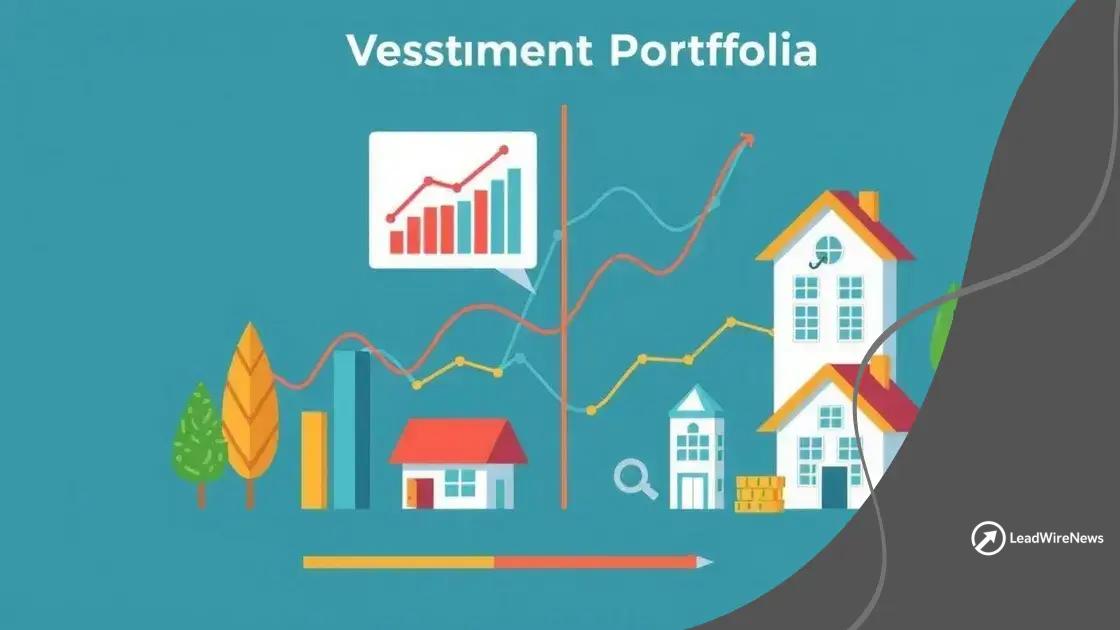Investment strategies resilient to inflationary pressures

Anúncios
Investment strategies resilient to inflationary pressures include diversifying assets across real estate, commodities, and inflation-protected securities while evaluating market risks and focusing on long-term financial goals for stability.
Investment strategies resilient to inflationary pressures can make all the difference in today’s economy. With rising costs affecting everyone, how do you protect your finances? Let’s dive into strategic approaches that may safeguard your assets.
Anúncios
Understanding inflationary pressures
Understanding inflationary pressures is crucial for making informed investment decisions. Inflation occurs when prices rise, which diminishes purchasing power. Many factors contribute to inflation, including demand for goods, production costs, and monetary policy.
Several indicators can help investors understand the current inflationary environment. Monitoring these can guide strategic decisions to protect investments. Among the key indicators are:
Key Inflation Indicators
- Consumer Price Index (CPI): Measures the average change over time in the prices paid by consumers for goods and services.
- Producer Price Index (PPI): Reflects the average changes in selling prices received by domestic producers for their output.
- Core inflation: Excludes volatile items like food and energy to give a clearer view of price trends.
Another aspect to consider is the role of monetary policy. When central banks adjust interest rates, it significantly influences inflation. High rates can slow down borrowing and spending, helping to reduce inflationary pressures.
Anúncios
On the other hand, low-interest rates can stimulate the economy, but they also risk increasing inflation. Understanding how these policies interact is vital for any investor aiming for long-term stability.
The relationship between inflation and investments is intricate. Certain asset classes tend to perform better when inflation rises. For example, real estate and commodities can be a hedge against inflation, as they often retain value when prices increase. By diversifying into these assets, investors can mitigate risks associated with inflation.
In summary, grasping inflationary pressures gives you a better perspective on the economic landscape. Awareness of this concept helps you make sound investment choices, especially in turbulent financial times.
Asset classes that thrive in inflation
Asset classes that thrive in inflation can protect and even enhance your wealth. When prices rise, certain investments tend to provide a better return or maintain their value. Understanding these asset classes is essential for making informed financial decisions.
One of the most prominent asset classes to consider is real estate. Property values often increase during inflationary periods, along with rental income. Investors who own real estate can benefit from rising prices as their properties gain value over time.
Key Asset Classes
- Commodities: Items like gold, silver, and oil are known to perform well during inflation because their prices naturally increase.
- Stocks: Certain sectors, such as utilities or consumer staples, typically maintain demand, enabling companies in these industries to pass on higher costs.
- Inflation-Protected Securities (TIPS): These government bonds are designed to increase in value with inflation, making them a reliable choice during inflationary times.
Another option is infrastructure investments. These assets, including power plants and roads, provide essential services and often benefit from the rising costs tied to inflation.
Moreover, investing in dividend-paying stocks can also be a smart move. Companies that regularly distribute dividends tend to be resilient during inflation, offering investors a steady income stream.
In summary, recognizing which asset classes thrive in inflation allows investors to make strategic decisions. By diversifying portfolios with these options, you can effectively hedge against inflation and maintain financial stability.
Tips for diversifying investments

Diversifying investments is a key strategy to manage risk and ensure stability in a fluctuating market. By spreading your funds across various asset classes, you can reduce the impact of poor performance in any single area. The goal is to create a balanced portfolio that can withstand economic shifts.
One effective way to achieve diversification is through asset allocation. This involves distributing your investments among different categories such as stocks, bonds, and real estate. Each class reacts differently to market conditions, which can help protect your overall investment.
Effective Diversification Strategies
- Invest across sectors: Look into various industries like technology, healthcare, and consumer goods to spread your risk.
- Include asset classes: Combine equities with fixed income securities (like bonds) and alternative investments (like real estate or commodities).
- Geographical diversity: Consider international investments to capture growth in emerging markets and mitigate risks tied to local economies.
Another factor to consider is rebalancing your portfolio periodically. This means reviewing your investments and adjusting them to maintain your desired level of asset allocation. If one asset class grows significantly, it may take up a larger portion of your portfolio, potentially altering your risk profile.
Investing in index funds or exchange-traded funds (ETFs) can also be a smart choice. These funds typically contain a broad range of securities, offering built-in diversification. They can be a cost-effective way to gain exposure to a wider market segment without needing to select individual stocks.
In summary, employing these tips for diversifying investments can create a solid foundation for your financial health. A well-diversified portfolio not only helps in managing risk but also increases the potential for long-term gains in various economic climates.
Evaluating risk during inflation
Evaluating risk during inflation is crucial for making sound investment decisions. Inflation can erode purchasing power, making it essential for investors to understand how it affects their portfolios. Risk assessment during this time involves analyzing various factors that could impact financial security.
One key aspect is understanding market volatility. Inflation often leads to uncertain economic conditions, which can cause erratic market movements. This unpredictability means that investments can fluctuate widely, increasing the risk of loss. Awareness of broader economic trends is vital in this environment.
Factors to Consider
- Interest rates: As inflation rises, central banks may increase interest rates, which can impact borrowing costs and investment returns.
- Sector performance: Different sectors react differently to inflation. For example, necessities like food and energy may perform better than luxury goods.
- Currency value: Inflation can weaken currency, affecting foreign investments and international purchasing power.
Another critical component is assessing your own financial readiness. This means examining personal finances, including debt levels and cash reserves. Keeping track of expenses can help gauge how inflation impacts your budget. It’s also essential to consider whether your investments are in line with your risk tolerance.
Furthermore, diversifying your investment portfolio is an effective way to mitigate risk. Investing in inflation-resistant assets like real estate and commodities can help protect against rising prices. By understanding the types of risks present during inflationary periods, investors can make better choices to safeguard their wealth.
Long-term planning in volatile markets
Long-term planning in volatile markets is essential for investors looking to secure their financial future. Market fluctuations can be unsettling, but with the right strategies, investors can navigate through uncertainty.
First, it’s important to establish clear financial goals. Understanding what you want to achieve can guide your investment choices. Whether it’s saving for retirement or funding education, having a target helps maintain focus, even when markets are unstable.
Strategies for Long-Term Planning
- Diversify your portfolio: Spreading investments across different asset classes can help reduce risk. This means combining stocks, bonds, and other types of investments.
- Stay informed: Keeping up with market trends and economic indicators can provide insights into how different sectors may perform over time.
- Consider dollar-cost averaging: Investing a fixed amount regularly can minimize the impact of market volatility, as you’ll buy more shares when prices are low and fewer when they are high.
Another strategy involves maintaining an emergency fund. This reserve can help you cover unexpected expenses without needing to liquidate investments in a downturn. Having liquid assets available can offer peace of mind during turbulent times.
Additionally, staying patient is crucial when investing for the long term. Markets will have ups and downs, but focusing on your long-term objectives rather than short-term fluctuations can lead to better results.
By implementing these strategies for long-term planning, investors can stay on track despite market volatility. A well-thought-out plan can build resilience, ensuring that financial goals remain achievable even in uncertain environments.
FAQ – Frequently Asked Questions about Investment Strategies During Inflation
What are the best asset classes to invest in during inflation?
Asset classes such as real estate, commodities, and inflation-protected securities (TIPS) often perform well during inflation.
How can diversification help mitigate risks in an inflationary environment?
Diversification spreads investments across various asset classes, reducing the impact of underperformance in any single area.
Why is it important to evaluate risk during inflation?
Evaluating risk helps investors understand market volatility and make informed decisions to protect their investments.
What strategies can be used for long-term planning in volatile markets?
Investors can establish clear financial goals, maintain an emergency fund, and stay informed about market trends to ensure stability.